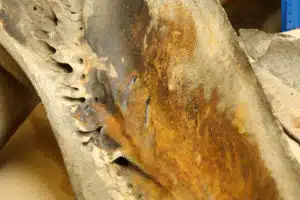While some say the wheel and others say agriculture and yet others say metal work, I think it is hard to say that the capacity of human beings to make fire on demand isn’t the most consequential invention or discovery by human beings.
I’d even go further to say that fire made humans beings in the first place. Fire had (and had) the unique capacity to take things that were inedible and make them edible and also to unlock nutrients to make them bioavailable in both meat and plant foods. And for proto-humans with growing brains that needed more and new kinds of nutrition fire was critical. With the advent of fire humans became fully bipedal and quickly developed what is called ‘the throwing shoulder’ which allowed for hunting and new kinds of dexterity.
There is even evidence that the movement of our oldest ancestors out of Africa was, in part, spurred by chasing new wood sources to burn for warmth and cooking.
If you’ve ever gone camping for a few days you know that searching for wood becomes a regular mid-afternoon event pretty quickly because you’ll need a decent stash by nightfall. So we can imagine this kind of world a little bit. Even in an urban environment it can be shocking how much wood falls in parks or on streets when storms blow through. Wood is around for a lot of us.
But what of the people who lived in places where wood was rare? Places like the Arctic or Iceland?
The Inuk or Inupiaq who live in the North American Arctic, or the Chukchi on the Asian side have an ancient and remarkable fire making pedigree. If they found drift wood of an appropriate size they used it to make bow-drills. They would collect plant matter in the spring and summer to use as tinder in the winter. They also used flints to make sparks into their tinder bundles as well.
But once the tiny fire got going and was fed with fat from whales or seals or walrus what they used to keep the fire going instead of logs were whale bones.
Whale bones are quite porous compared to terrestrial animals and all those cavities in the osseous material are filled with whale fat or marrow. While the marrow was eaten the bones and the fat were the perfect slow burning material to make it through winter.
For you and I, fire is virtually a sure thing. Turn on your gas stove or grab the box of matches or the lighter and all the benefits of fire are at your hand. You can chop down a tree or get bundles of split and kiln dried wood delivered to your door. Your candles are easily lit to gently push away the darkness more kindly than flipping the switch in your living room.
And for these northern people light and heat and living meant and means hunting of all kinds. But it this particular kinship that these people had and have with whales that allowed them to truly be in relationship with the place. They learned where whales slept and how to spear them through the heart while they slept – if they could – just once a year. Sustainable and with uncertain outcomes.
Could it be that in order to become more human and to become more in concert with the place that sustains you a profound relationship with animals and with their death might be mandatory? What crafts and what skills and what culture is practiced in preparing for such a thing?
I think a case can be made for such a thing. For many the curiosity of trying whale meat exists but the Inuk and the Chukchi and the Inupiaq show that the meat and fat were not the only valued parts. How often and how easily do we so easily throw away our chicken bones or suck the meat off a rib of a pig and easily toss the bone away?
It was in the bones that the capacity for a deeper life in such a place could be revealed.
Here at Primal Derma we adore cultural signs like this and use it to buttress our case and purpose for using something that honors the life of the whole animal and using a part that all too often gets thrown away so that we might have a chance to have a bit more health and become, maybe, a bit more human, having to contend with an ending.
Thanks so much for continuing to contend with stories like this and for supporting Primal Derma.
If you need some more, we would love to send you some. Press ‘Shop Now’ below and we’ll get it to you as soon as we can.
Until soon
Matt


